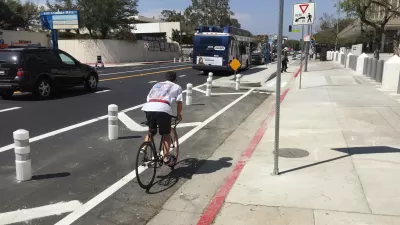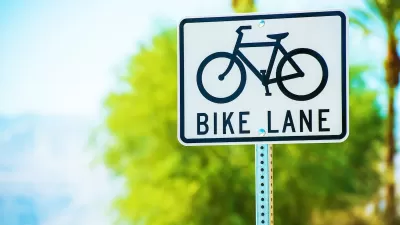City planners say limiting protected bike infrastructure to smaller streets isn’t enough to create a safe, connected bikeway network that reaches all parts of the city.

Denver planners are suggesting a change to the city’s bike lane strategy. After years of adding bike lanes to side streets, transportation planners now want to begin adding protected bike lanes to major arterial roads. “Some of the new bike lanes would be part of a new ‘core network’ that would help cyclists travel more directly over longer distances. They would use high-quality, permanent materials like concrete and would accommodate a high volume of cyclists, planners say.”
According to an article by Nathaniel Minor in Denverite, “Some of the city’s current bike lanes and low-traffic “neighborhood bikeways” abruptly end. Or, as with the 16th Avenue bike lane in the Uptown neighborhood, they run a block or two parallel to busy commercial corridors full of shops, restaurants and other destinations.” Putting more bike lanes on major roads would help people on bikes reach their destinations more easily and safely and avoid a ‘last-mile’ gap where they have to ride in mixed traffic or walk their bikes. Minor adds, “Denver law prohibits riding a bicycle on a sidewalk under most circumstances, but it makes an exception for cyclists reaching their final destination.”
Any changes to state highways such as Colorado Boulevard would require approval from the Colorado Department of Transportation (CDOT). CDOT officials say the agency is currently planning a new bus rapid transit (BRT) line for that road, as well as sidewalk improvements.
FULL STORY: Denver’s next big bike lane strategy: more protected lanes on busier streets

Alabama: Trump Terminates Settlements for Black Communities Harmed By Raw Sewage
Trump deemed the landmark civil rights agreement “illegal DEI and environmental justice policy.”

Planetizen Federal Action Tracker
A weekly monitor of how Trump’s orders and actions are impacting planners and planning in America.

How Atlanta Built 7,000 Housing Units in 3 Years
The city’s comprehensive, neighborhood-focused housing strategy focuses on identifying properties and land that can be repurposed for housing and encouraging development in underserved neighborhoods.

In Both Crashes and Crime, Public Transportation is Far Safer than Driving
Contrary to popular assumptions, public transportation has far lower crash and crime rates than automobile travel. For safer communities, improve and encourage transit travel.

Report: Zoning Reforms Should Complement Nashville’s Ambitious Transit Plan
Without reform, restrictive zoning codes will limit the impact of the city’s planned transit expansion and could exclude some of the residents who depend on transit the most.

Judge Orders Release of Frozen IRA, IIJA Funding
The decision is a victory for environmental groups who charged that freezing funds for critical infrastructure and disaster response programs caused “real and irreparable harm” to communities.
Urban Design for Planners 1: Software Tools
This six-course series explores essential urban design concepts using open source software and equips planners with the tools they need to participate fully in the urban design process.
Planning for Universal Design
Learn the tools for implementing Universal Design in planning regulations.
Jessamine County Fiscal Court
Caltrans
Institute for Housing and Urban Development Studies (IHS)
City of Grandview
Harvard GSD Executive Education
Toledo-Lucas County Plan Commissions
Salt Lake City
NYU Wagner Graduate School of Public Service





























